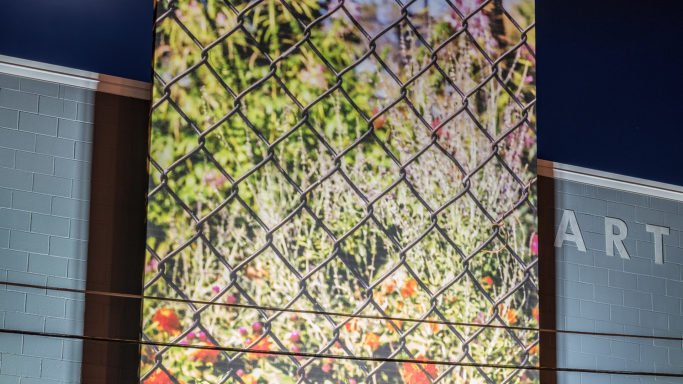
Paul Anthony Smith
08.25.2018 - 02.28.2019
Paul Anthony Smith, Fence (Dreams Deferred), 2016-2018
As a way to observe and understand a place, Paul Anthony Smith has developed a practice of walking, building an archive of sensory impressions and assembling a photographic collection of remarkable and unremarkable images. This nearly daily practice of walking is leading Smith on a slow meditation, wherein he is able to contemplate what it means to move through American cities during a particular moment – cities like New York, Philadelphia, Chicago, and Kansas City – at a time when knowledge of this country’s troubled present and past makes a question of its future.
Brooklyn’s neighborhood of Bedford-Stuyvesant, near the artist’s home and studio, is a frequent route for Smith and, in some respects, the subject of the straightforward, unadorned image Fence (Dreams Deferred). An important cultural center for Brooklyn’s African-American community for decades with a rich and complicated history, this community is directly in the path of rapid economic development. Profound shifts in this urban landscape are beginning to reshape the nature, fabric, scale, and population of the community, for better and worse.
Like many neighborhoods throughout New York, as well as many urban centers across the wide stretch of America, Bed Stuy is showing the visible signs of aggressive, opportunistic real estate development, resulting in the kind of change that leads to gentrification, displacement of those with the fewest advantages, and leaving a range of social and demographic stresses in its wake. It’s a topic that features in much of Smith’s recent work, including Fence (Dreams Deferred), an image depicting the enclosed gardens of Marcy Project which subtly disguises the populated common-space of one of New York City Housing Authority’s most notorious housing projects.
After receiving his BFA from the Kansas City Art Institute and before moving to New York, Smith traveled to his family’s home in Jamaica. Upon his return, he began to explore the role of memory, experimenting with an archive of found and original photographic images. These photo-based works, sometimes collaged and overlaid with various techniques and materials, often contain references to chain-link fences and concrete walls. These indicators of architectural space suggest articulations of social structures and borders, inviting us to think about property, belonging, security, and inclusion/exclusion.
Employing a technique he refers to as picotage, Smith often adorns an image with a scarred surface, creating an effect that is both textural and optical. It’s also a gesture of abstraction, serving to disrupt or complicate the legibility of an image by screening and withholding information that would otherwise be revealed.
In the case of Fence (Dreams Deferred), commissioned for the Artspace Project Wall and distinguished from other works by a drastic jolt in scale and orientation, the artist has withdrawn his signature approach to abstracting the image. Instead, the focus of the camera’s lens shifts our attention directly to the stark and dividing presence of the chain-link fence, allowing the blur to occur on its own as the garden on the fence’s far side grows hazy and indistinct. Drawn from an ongoing series of photo-based works begun in 2016, the work’s title is inspired by Harlem, a poem by Langston Hughes that wants to know, “What happens to a dream deferred?”
Looking up at the Smith’s Project Wall from this street-level perspective, it’s difficult to distinguish whether the garden’s beauty is an unlikely accident, beautification of something otherwise unremarkable, or a calculated gesture to conceal something and obscure its full significance. Should we read more deeply into the fact that Smith has veiled the true and exact location of the fence, making us search all that is revealed in the close-up image and the work’s title? If we bring a sense of open curiosity to our reading of the shadowy landscape behind the fence, are we left to wonder if it masks the presence of the human figure, leaving it in the shadows and rendering it – just as decades of institutional racial segregation in cities like Brooklyn, Philadelphia, Chicago, and Kansas City – mostly indistinguishable to the viewer?
Paul Anthony Smith
Paul Anthony Smith was born in 1988 in Jamaica and, from the age of 9, grew up in Miami where he attended the New World School of the Arts. In Kansas City, he studied ceramics and received his BFA from the Kansas City Art Institute in 2010. Smith currently lives and works in Brooklyn, New York. His work has been acquired by numerous public collections, including the Minneapolis Institute of Art and the Blanton Museum at the University of Texas, Austin and has been featured in numerous museum exhibitions, including a solo show at the Atlanta Contemporary, a two person show at the Philadelphia Photo Arts Center, and group shows at the New Museum, Brooklyn Museum of Art, the Nasher Museum of Art at Duke University, the Seattle Art Museum, the Studio Museum in Harlem, and the Nerman Museum of Contemporary Art, among others. He has had exhibitions with Zieher Smith in New York; mild climate in Nashville, TN; and Brand New Gallery in Milan, Italy. An exhibition of new work will open in September 2018 at Luis de Jesus in Los Angeles, CA.
In partnership with Open Spaces KC: the Expanded Field.